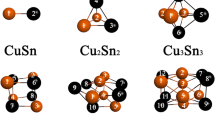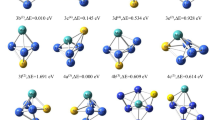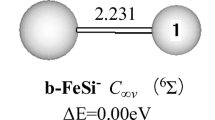Abstract
We report a theoretical study on small copper clusters Cu νn (ν= ±1,0,2; n=3-13). We have published the optimized geometries in a previous paper, obtained with a gradient embedded genetic algorithm (GEGA) technique, and further density functional theory (DFT) geometry reoptimization of the best GEGA cluster structures for each size and charge. For the lower energy isomers of these clusters, we report in this paper the total all-electron energies and electronic properties such as the adiabatic ionization potentials, electron affinities, global hardnesses, and binding energies. Furthermore, we compute for each possible fragmentation channels of cationic copper clusters, the involved energetics, ΔE, and the extended-hardness change, Δη, based on the maximum hardness principle of Pearson and Chattaraj, Lee, and Parr, within the conceptual DFT formalism, but where η is computed with adiabatic rather than vertical energies. Both methods are shown to be in very good agreement with most available experimental findings. We argue that extended-hardness and the extended-hardness change are good DFT descriptors to assess the preferred fragmentation channels of charged copper clusters, where formation of the hardest fragments seems to be the driving force. Our theoretical results suggest that relaxation in these species is perhaps faster than usually assumed in the experiments performed to measure their fragmentation.
Similar content being viewed by others
References
J.A. Alonso, Chem. Rev. 100, 637 (2000)
V.A. Spasov, T.H. Lee, K.M. Ervin, J. Chem. Phys. 112, 1713 (2000)
M.F. Jarrold, K.M. Greegan, Int. J. Mass Spectrom. Ion Proc. 102, 161 (1990)
O. Ingólfsson, U. Busolt, K. Sugawara, J. Chem. Phys. 112, 4613 (2000)
S. Krückeberg, L. Schweikhard, J. Ziegler, G. Dietrich, K. Lützenkirchen, C. Walther, J. Chem. Phys. 114, 2955 (2001)
M. Vogel, A. Herlert, L. Schweikhard, J. Am. Soc. Mass Spectrom. 14, 614 (2003)
G. Guzmán-Ramírez, F. Aguilera-Granja, J. Robles, Eur. Phys. J. D 57, 49 (2010)
R.G. Parr, W. Yang, Density-Functional Theory of Atoms and Molecules (Oxford University Press, 1989)
R.G. Parr, R.G. Pearson, J. Am. Chem. Soc. 105, 7512 (1983)
R.G. Pearson, J. Chem. Edu. 64, 561 (1987)
R.G. Pearson, Chemical Hardness (Wiley, 1997)
P.K. Chattaraj, H. Lee, R.G. Parr, J. Am. Chem. Soc. 113, 1855 (1991)
M.K. Harbola, Proc. Natl. Acad. Sci. USA 89, 1036 (1992)
R.G. Parr, Z. Zhou, Acc. Chem. Res. 26, 256 (1993)
R.G. Pearson, W.E. Palke, J. Phys. Chem. 96, 3283 (1992)
A.N. Alexandrova, A.I. Boldyrev, J. Chem. Theory Comput. 1, 566 (2005)
A.N. Alexandrova, A.I. Boldyrev, Y. Fu, X. Yang, X. Wang, L. Wang, J. Chem. Phys. 121, 5709 (2004)
M.J. Frisch et al., Gaussian 98, Revision A.7 (Gaussian, Inc., Pittsburgh PA, 1998)
M.J. Frisch et al., Gaussian 03, Revision D.02 (Gaussian, Inc., Wallingford CT, 2004)
J.C. Slater, Quantum Theory of Molecular and Solids (McGraw-Hill, 1974), Vol. 4
S.H. Vosko, L. Wilk, M. Nusair, Can. J. Phys. 58, 1200 (1980)
P.J. Hay, W.R. Wadt, J. Chem. Phys. 82, 270 (1985)
A.D. Becke, Phys. Rev. A 38, 3098 (1988)
C. Lee, W. Yang, R.G. Parr, Phys. Rev. B 37, 785 (1988)
G. Guzmán-Ramírez, A. Segovia-Ríos, J. Sierra-Arellano, J. Robles, J. Comput. Meth. Sci. Eng. 7, 507 (2007)
T. Koopman, Physica 1, 104 (1934)
E.M. Fernández, J.M. Soler, I.L. Garzón, L.C. Balbás, Phys. Rev. B 70, 165403 (2004)
K. Jug, B. Zimmermann, P. Calaminici, A.M. Köster, J. Chem. Phys. 116, 4497 (2002)
A.M. James, G.W. Lemire, P.R.R. Langridge-Smith, Chem. Phys. Lett. 227, 503 (1994)
M.B. Knickelbein, Chem. Phys. Lett. 192, 129 (1992)
D.E. Powers, S.G. Hansen, M.E. Geusic, D.L. Michalopoulos, R.E. Smalley, J. Chem. Phys. 78, 2866 (1983)
J. Ho, K.M. Ervin, W.C. Lineberger, J. Chem. Phys. 93, 6987 (1990)
C.E. Moore, Atomic Energy Levels (Natl. Bureau of Standards, 1971), Vol. II
C.L. Pettiette, S.H. Yang, M.J. Craycraft, J. Conceicao, R.T. Laaksonen, O. Cheshnovsky, R.E. Smalley, J. Chem. Phys. 88, 5377 (1988)
C. Kittel, Introduction to Solid State Physics (Wiley, 2005)
Author information
Authors and Affiliations
Corresponding author
Rights and permissions
About this article
Cite this article
Guzmán-Ramírez, G., Aguilera-Granja, F. & Robles, J. DFT study of the fragmentation channels and electronic properties of Cu νn (ν= ±1,0,2; n=3-13) clusters. Eur. Phys. J. D 57, 335–342 (2010). https://doi.org/10.1140/epjd/e2010-00059-x
Received:
Revised:
Published:
Issue Date:
DOI: https://doi.org/10.1140/epjd/e2010-00059-x




